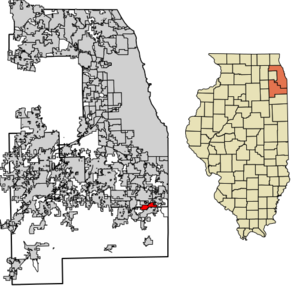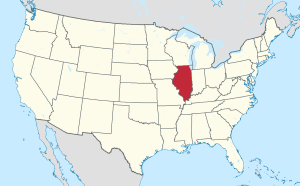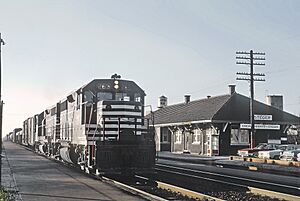Steger, Illinois facts for kids
Quick facts for kids
Steger, Illinois
|
||
|---|---|---|
|
||

Location of Steger in Cook County, Illinois.
|
||

Location of Illinois in the United States
|
||
| Country | United States | |
| State | Illinois | |
| Counties | Will, Cook | |
| Townships | Bloom (Cook), Crete (Will) | |
| Founded | 1896 | |
| Area | ||
| • Total | 3.40 sq mi (8.82 km2) | |
| • Land | 3.40 sq mi (8.82 km2) | |
| • Water | 0.00 sq mi (0.00 km2) | |
| Elevation | 702 ft (214 m) | |
| Population
(2020)
|
||
| • Total | 9,584 | |
| • Density | 2,815.51/sq mi (1,087.08/km2) | |
| Time zone | UTC-6 (CST) | |
| • Summer (DST) | UTC-5 (CDT) | |
| ZIP Code(s) |
60475
|
|
| Area code(s) | 708 | |
| FIPS code | 17-72520 | |
Steger is a village located in Cook County and Will County, Illinois, United States. It is about 35 miles (56 km) south of the big city of Chicago. In 2020, about 9,584 people lived there.
Contents
A Look Back in Time
Steger was started in 1891 by people interested in real estate from Chicago. It was first called Columbia Heights. This name honored the 1893 World's Columbian Exposition, a huge fair that Chicago was getting ready to host.
A man named John Valentine Steger built a large piano factory in the area. It was located south of Chicago Heights. By 1904, this factory was huge, covering 23 acres (9.3 ha). It could make sixteen thousand pianos every year!
Steger became an official village in 1896. At that time, 324 people lived there. John Steger helped pay for the village to become official. In return, the town agreed to change its name to Steger. John Steger later served as the village's board president for two terms. He wanted people to own their own homes and businesses. This helped Steger avoid problems that other "model towns" had faced. By 1920, Steger was known as the "piano capital of the world." It made over a hundred pianos every day! However, people stopped buying as many pianos, and the factory closed in 1928.
Where is Steger?
Steger is a village that covers about 3.45 square miles (8.94 square kilometers) of land. It does not have any large bodies of water within its borders.
Who Lives in Steger?
| Historical population | |||
|---|---|---|---|
| Census | Pop. | %± | |
| 1900 | 712 | — | |
| 1910 | 2,161 | 203.5% | |
| 1920 | 2,304 | 6.6% | |
| 1930 | 2,985 | 29.6% | |
| 1940 | 3,369 | 12.9% | |
| 1950 | 4,358 | 29.4% | |
| 1960 | 6,432 | 47.6% | |
| 1970 | 8,104 | 26.0% | |
| 1980 | 9,269 | 14.4% | |
| 1990 | 8,584 | −7.4% | |
| 2000 | 9,682 | 12.8% | |
| 2010 | 9,570 | −1.2% | |
| 2020 | 9,584 | 0.1% | |
| U.S. Decennial Census 2010 2020 |
|||
In 2020, Steger had 9,584 people living there. The village has a mix of different backgrounds. About half of the people are White. A quarter of the people are Black or African American. About one-fifth of the people are Hispanic or Latino. There are also people from Asian, Native American, and other backgrounds. Some people identify with two or more races.
Fun Things to Do
Steger has two main parks where people can relax and play. They are called Harold Hecht (Fireman's) Park and Veteran's Park. These parks offer places for outdoor activities and community gatherings.
Getting Around
Pace is a bus service that helps people get around. Route 358 connects Steger to downtown Chicago Heights and other places. Steger is also planned to be a stop on Metra’s SouthEast Service. This would bring commuter train service back to the area, which hasn't had it since 1935.
Famous Faces
Many interesting people have come from Steger, Illinois. Here are a few:
- Terry Boers: A sports writer and talk show host.
- Luke Butkus: An assistant coach for NFL teams like the Jacksonville Jaguars. He also coached at the University of Illinois.
- Flora Ciarlo: She was a state legislator in Illinois.
- Mike Downey: A newspaper writer for Los Angeles and Chicago papers.
- Debbie Halvorson: She used to be a United States Congresswoman.
- John Holecek: A linebacker who played for NFL teams like the Buffalo Bills and San Diego Chargers.
Images for kids
See also
 In Spanish: Steger (Illinois) para niños
In Spanish: Steger (Illinois) para niños




